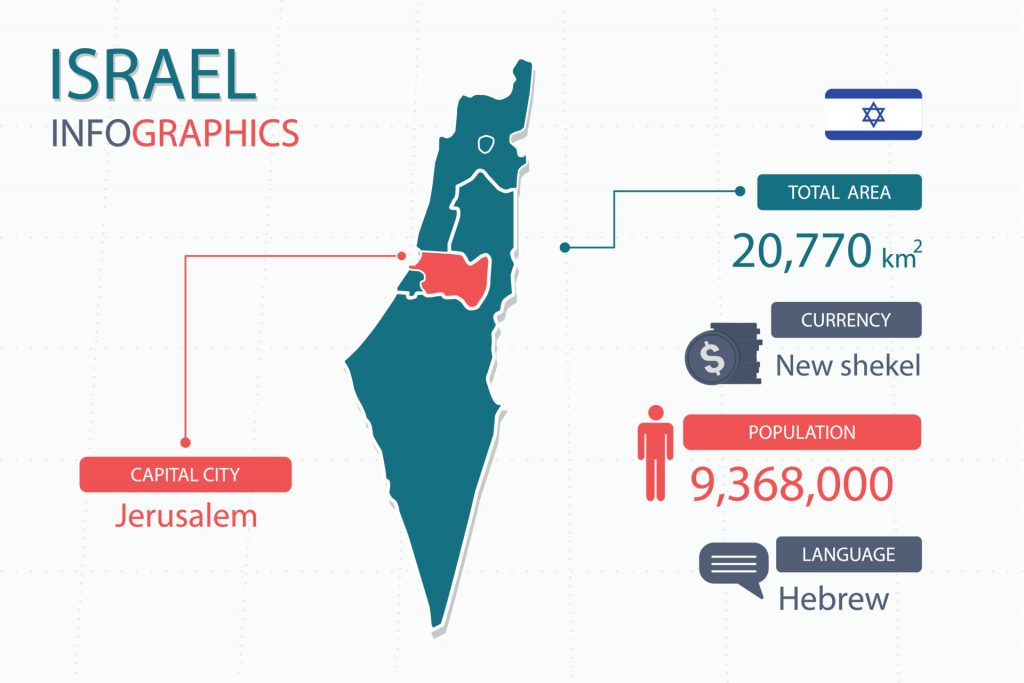The origins of the Hebrew Language
Hebrew refers to Modern Hebrew that is used in Israel. It can also refer to the language used in Jewish communities around the world mainly for religious purposes, which is slightly different. It carries heavy historical significance in politics and religion, being considered the language of the Israelites. The earliest examples of writing in Hebrew dates back to the 10th century BCE. Hebrew is considered a successfully revived dead language, where at one point people ceased to speak it, but then a community made efforts to use and update it.
Hebrew is spoken mostly in Israel and the United States, even though there are other areas where it may be spoken, especially ones with a heavy Jewish population. Worldwide, over 9 million people speak it. About 5 million people are considered native speakers, and most of these speakers reside in Israel. In 200-400 (BC,AD?), the use of Hebrew as a spoken language ceased and Jewish populations at this time spoke either Aramaic and Greek, depending on the region where these populations resided. Even though it may have been overtaken, it was still used as a liturgical language. In the 19th century, there was an effort to revive it both as a spoken and literary language. After, it became the lingua franca for Palestinian Jews, and subsequently the state of Israel.
The Hebrew alphabet is classified as an abjad. In this type of writing system, consonants are prominently featured and vowels are mostly inferred from context, and thus, not written out. This is similar to the Arabic and Persian writing systems. In general, the Hebrew alphabet consists of 22 letters. However, vowels may be indicated, especially in Modern Hebrew. The Hebrew alphabet is also used to write many other languages, especially ones with close ties to the Jewish diaspora; these include Yiddish and certain Judeo-Arabic varieties.
Hebrew historically stems from the Canaanite group of languages. It is Branch of the Northwest Semitic language. In general, it is quite difficult to distinguish Ancient Hebrew writings from other Canaanite languages; scholars are still uncertain whether certain writing belongs to Hebrew or other languages prevalent in the regions at the time.

The history of Hebrew starts with Classical Hebrew. It is also called Biblical Hebrew. Most of the texts that became the Bible were written in Biblical (Classic) Hebrew and the very first translation of the Bible was into Greek. The Bible is still the most translated book in the world and the Hebrew Bible translation has naturally been a very specialized field among scholars.
Biblical or Classic Hebrew refers to the spoken language of ancient Israel between the 10th century BCE to the 4th century CE. Biblical Hebrew is split into different phases, and under these, have undergone different changes. Various periods of Biblical Hebrew have existed, namely Standard Biblical Hebrew, Late Biblical Hebrew, and Israelian Hebrew (Israelian Hebrew is mostly based on text). The earliest examples of Biblical Hebrew can be attributed to the Dead Sea Scrolls, manuscripts that date back to the 8th century BCE containing texts such as Hebrew scriptures, works that not officially canonized in the Hebrew Bible, and other types of manuscripts.
In the 6th century, Hebrew began to be displaced by Aramaic. When the Kingdom of Judah was conquered, Israelites learned Aramaic, and this was especially true of the Jewish elite who wanted to maintain power and prestige. Texts found from this era show signs of the language’s evolution which is very interesting for linguistic scholar. Thus, Hebrew can be considered at the time to be a very local language, while Aramaic and Greek were more ‘international’ languages that served as a lingua franca among a number of different peoples. After the Roman Empire, Hebrew was considered a purely written language, and more specifically, a language used for liturgy in Judaism.
The next phase of Hebrew is called Mishanic Hebrew, and it is represented by the language found in the Talmud.
The period of Medieval Hebrew saw an emergence of grammars trying to describe and explain grammar rules of Biblical Hebrew. While this Hebrew still remained a liturgical and literary language, there is evidence of borrowings from both the Greek and Arabic that existed at the time. In addition, it was a language that was also used in philosophy, science, medicine, and other important fields that might not necessarily be related to religion.
The language, then, seemed to have survive as a literary language and there were times of development of evolution. However, among the majority of this time, it was not a spoken language. Despite this, there were opportunities to revive it as an spoken language as well. This version of Hebrew started to replace Jewish dialects of other local languages, which included Judeo-Spanish, Judeo-Arabic, versions of Persian, and Yiddish, among other languages. This new emergence had made Hebrew a new unifying language for Jewish communities and became known as Modern Hebrew.
Modern Hebrew took borrowings and coined neologisms from the overall Hebrew literary tradition as well as the Hebrew bible, but a heavy influence of Arabic was also apparent. As the language needed to reflect more modern circumstances and concepts, many new words were coined that stemmed from number of European languages, including English, French and German. It became one of the official languages of Palestine in 1921, when it was ruled by the British, along with Arabic and English. When the State of Israel was formed in 1948, it was declared the official language.
In modern times, Standard Hebrew is based on Mishanic spelling and Sephardi Hebrew pronunciation, and this Hebrew is the one that is spoken in Israel. However, it’s development remains dynamic because of the various cultures and influences that have touched upon Jewish communities around the world, their cultures, and their individual linguistic varieties.
VEQTA can provide you with a perfect Hebrew translator for your Hebrew translation, English to Hebrew translation and Hebrew to english translation for the your targeted locale. Our translations to Hebrew are created with your target audience in mind to meet your expectations.
If you need to translate Hebrew – Get in touch today!
A dedicated team of Hebrew translators who combines Experience, Specialized Subject Matter Expertise with best Translation Practices to deliver quality second to none.
Hebrew Subject Expertise
Hebrew Translators
Hebrew Editors
Hebrew Copywriters
Hebrew Reviewers
Hebrew Voice dubbing
Hebrew Subtitling
Hebrew Transcription


